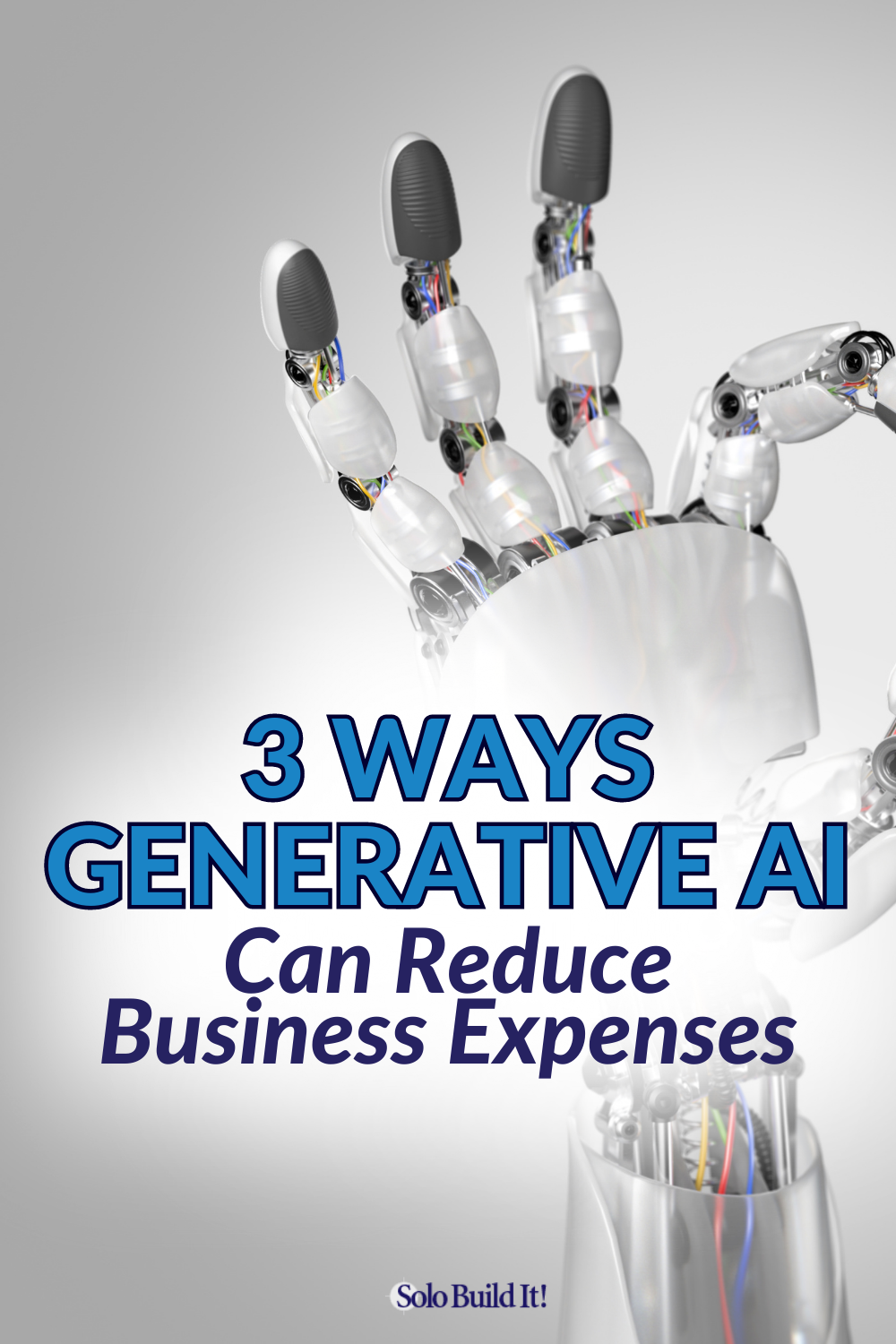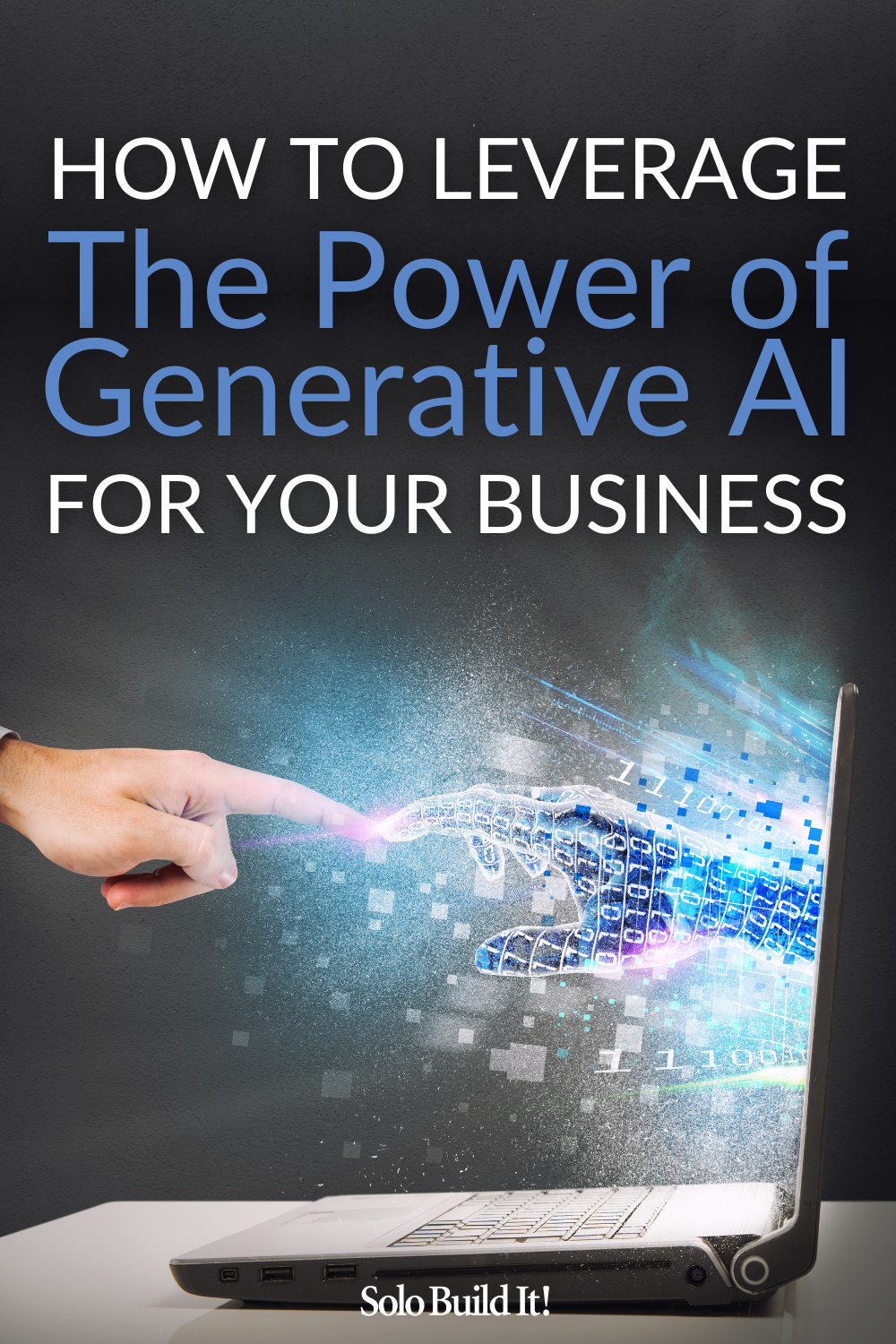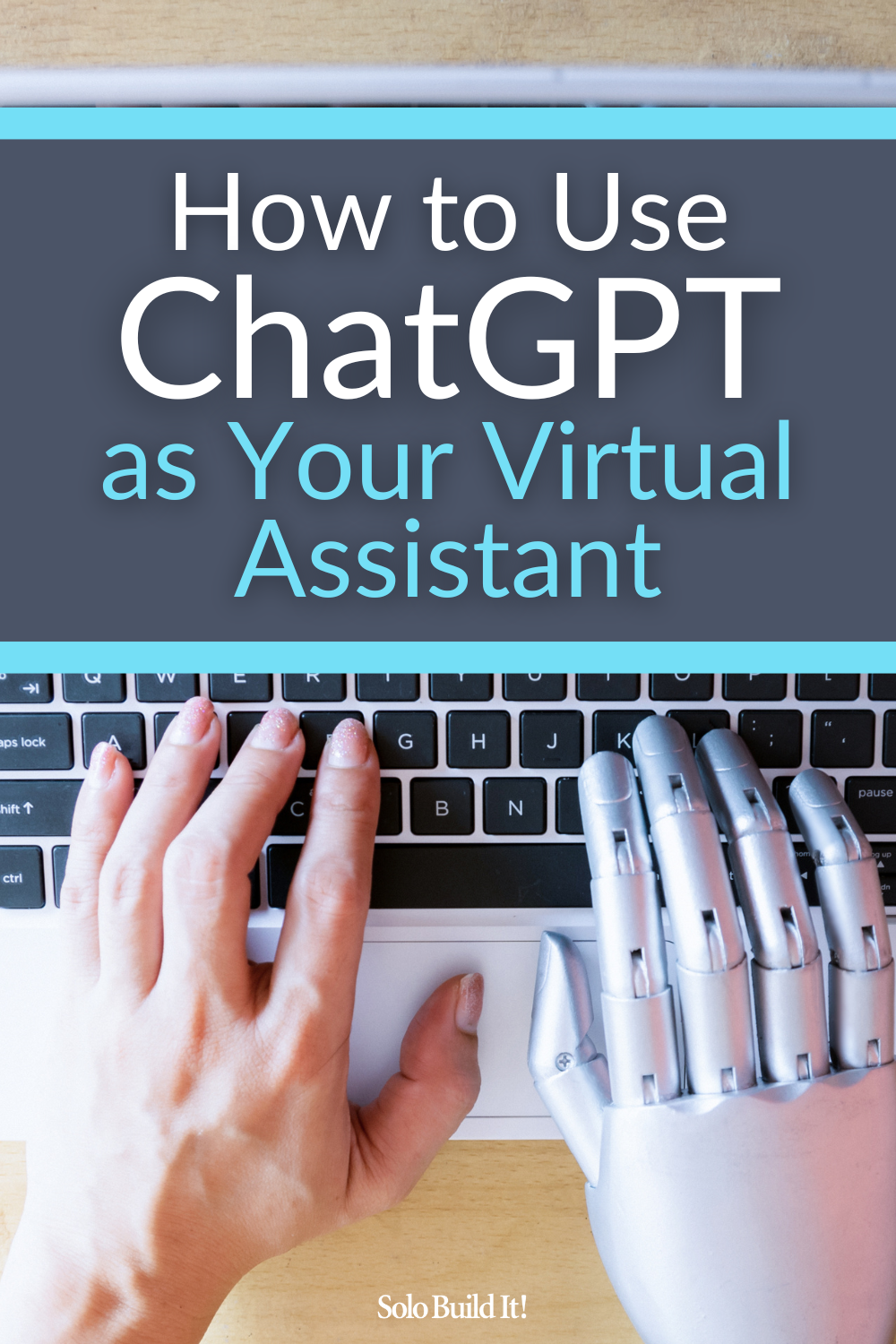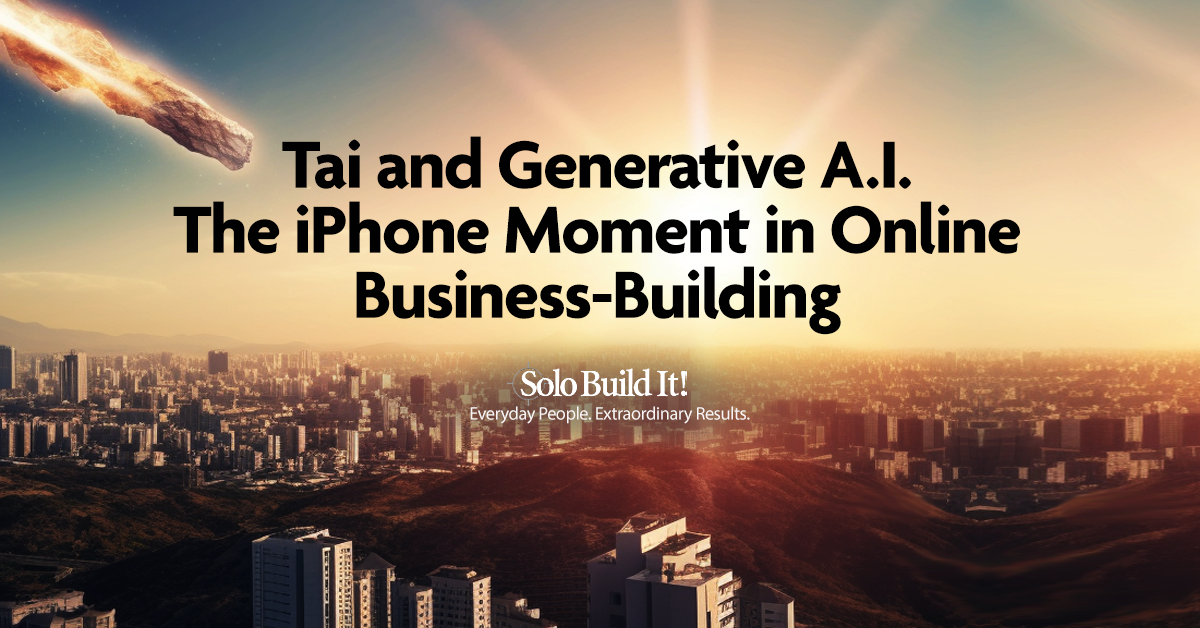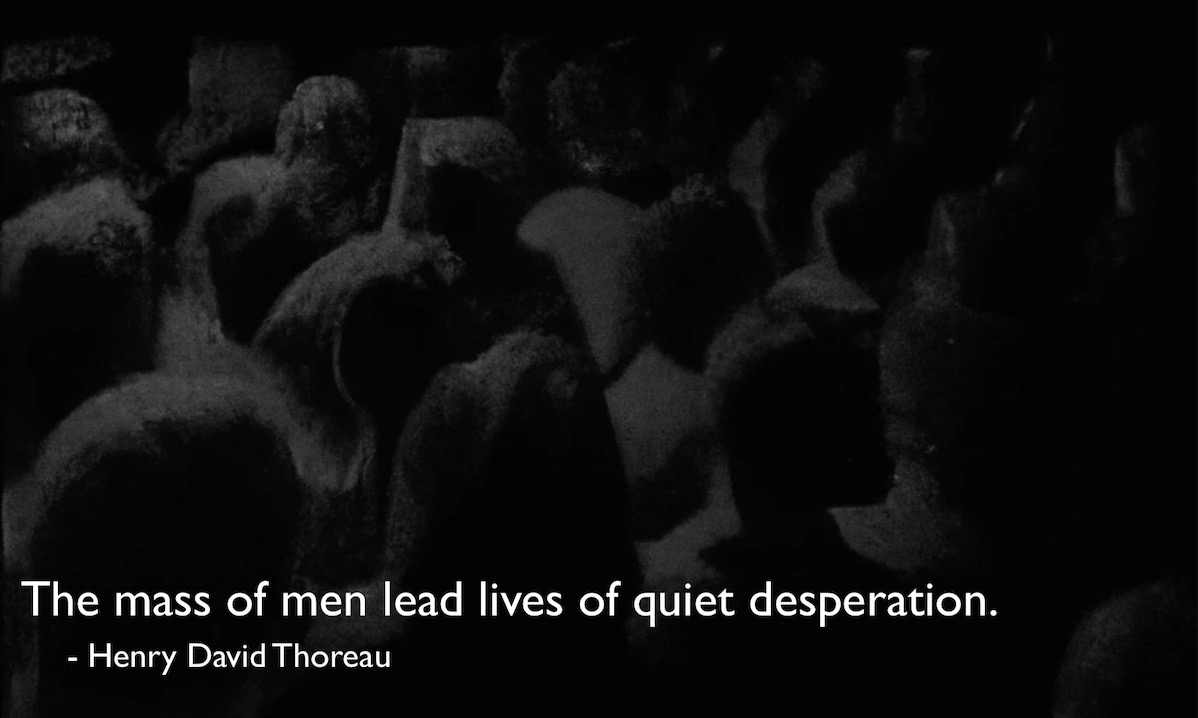Foreword: What’s the Goal?
Generative AI (“GAI”) has hit the planet with the metaphorical force of a meteor. The potential impact of AI on business, or on your plans to start one, ranges from extremely beneficial to “as destructive as a meteor.”
I consider this series of seven articles, therefore, to be the most important information we’ve shared since we launched SBI! itself, way back in late 2001. The goal is to give you a complete understanding of GAI, foundational knowledge, so that…
- you know how to use GAI, including its lead product, OpenAI’s ChatGPT, and others, to accelerate the growth and profitability of your web-based enterprise.
- you prioritize doing this to the top, not only to build a bigger and stronger business (faster than you now realize), but also because competitors will absolutely be doing it. By this point, a few have already started.
- you have a strong, mid-level grasp of all the most important, general A.I. concepts and how everything fits together. Without a confident sense of where this has been / is now / and will be heading, and without a firm grasp of the bigger picture, the requisite business vision (and your commitment to it) will be either absent or askew.
- you succeed, by which I mean you’ll use GAI to accelerate the growth of your business, increasing its revenues while decreasing expenses.
To increase your Net Income (revenues – expenses), aka “Profit,” apply the principles and other revelations you’ll read about in this series to execute the day-by-day, nitty-gritty steps required. You’ll exploit the power and efficiency of GAI to simultaneously grow income and reduce expenses.
The bottom line of growing revenues while cutting expenses can only result in higher profits — profits at a level that you would have considered unlikely prior to that landmark day in November, 2022 when OpenAI announced ChatGPT to the world.
A Dramatic Study by a Big Bank
In a March, 2023 study, Goldman Sachs concluded…
- two-thirds of US jobs are exposed to automation by A.I.
- of those affected, up to 50% of their workload could be replaced
- 7% of US jobs could be replaced by A.I.
- 25% of all tasks performed in the US and Europe could be automated by A.I.
College graduates and knowledge workers are the most at risk. Following are the highest risk jobs…
- office and administrative support positions (46%)
- legal positions (44%), and
- architecture and engineering jobs (37%).
I believe those numbers are low because they’re based on the power of GAI as we understand it now. However, in just a few years, it will be orders of magnitude more sophisticated and powerful.
Why does this matter to you? As a solopreneur, you are your highest expense when you’re starting out. As you grow, paying people who work for you, whether full-time or part-time, salaried, freelance or on contract, will continue to be your highest expense. You’ll need to have a solid understanding on the impact of AI on business.
Many solopreneurs pay themselves nothing when starting out. That’s fine, since there’s no point in moving money from your left pocket to your right pocket and calling it income.
However, most continue that practice for too long. When a solopreneur tells me that he made a $20,000 profit in the previous year, I always ask if she pays herself a monthly salary.
Few do, which means that the business was not profitable at all. Instead, if you “plug in” an (imaginary) expense of $50,000 for that salary, that business lost $30,000.
If the concept of paying yourself, imaginary or not, seems like splitting hairs, it’s not. It puts your business on a more rigorous foundation.
Your goal should not be to pay your salary “one day.” Instead, you should be aiming to maximize profits by growing income and keeping expenses to the minimum necessary for growth.
And speaking of expenses…
How Does GAI Help Reduce Expenses?
- Increasing your productivity by, say, 50%, means you generate more income through a greater volume of high quality content, while you delay hiring writers to deliver that much high-value content for you. That keeps expenses down when it matters most, when money is tightest.
- As your business grows and becomes profitable, you’ll “hire” GPT to not only create content for you, but to also handle many of the time-consuming, routine “chores” that you do in the course of a day, from replying to emails to writing pitch emails to potential advertisers.This YouTube video covers the tremendous number of non-content-building “duties” that GPT can do. At some point, you’ll hire one “real” person to use GPT to do all that stuff that you don’t want to do.
If your goal is to build a profitable business of any significance, you’ll need one. The point is that you used to need many (pre-GPT). That represents a significant drop in expenses.
- If your business is already profitable and if you already employ full- or part-time human assistants, you won’t need as many thanks to GPT! As per the previous point, you may only need one to do all those tasks, perhaps contracting here or there for highly specialized ones.
Tip: When hiring, don’t use anyone who claims not to be using GPT. They’re either inefficient, behind the times, or lying to you.
You should be paying less for the same job, on the basis that it takes much less time to get it done than in pre-GAI days. (It may take some time for the market to recognize this reality, but it’s inevitable.)
When you complete this series, you’ll be ready to use GPT* optimally, to take maximum advantage of all it offers and thereby outpace your competition.
*I’ll use “GPT” throughout this seven-part series to mean (according to the context) GPT-3, ChatGPT, or GPT-4. Don’t worry if you don’t know what GPT is yet.
I’ll cover that soon.
I won’t be talking about expenses for the rest of this series. Just know that, compared to as late as November, 2022, you start with a substantial advantage on the expenses side of the ledger.
From this point, we’ll focus on the impact of AI on business and using GPT to grow your income. The big 90-10 solution on this side of the ledger focuses on using GPT to build traffic-generating content.
But please don’t forget, as many solopreuners do, that a dollar saved in expenses may not be as exciting as a dollar earned, but it’s just as valuable!
Ready?🚦
The series starts by setting the context. GAI’s place in history leads to your spot in the future.
Tai and Generative A.I., Part 1
A Century of Innovation Context… The Power of Converging Technologies
One hundred years ago, three world-changing (aka “disruptive”) technologies — the telephone, the internal combustion engine (I.C.E.) and electricity — reached “ready for prime-time” status all around the same time.
The propagation of a single disruptive technology is enough to drive massive, worldwide progress. They occur rarely, though — every 10 to 50 years — truly “generational.” So it’s rare that three converge.
Rare… and extremely powerful. Even the term “revolutionary” doesn’t do the impact, from personal to planetary, justice.
Gradually, Then All At Once
Studies of new disruptors show that…
- they progress and grow gradually at first, usually upon the foundation of earlier disruptors, getting better and cheaper, until suddenly…
- the benefit-to-cost ratio reaches a tipping point, at which time the disruptor seems to explode out of nowhere to suddenly achieve “how did we ever live without this” status.
In Ernest Hemingway’s masterpiece, The Sun Also Rises, Mike, the central character, is asked how he went bankrupt…
“Gradually, then suddenly” says it all.
This brilliant dynamic has since been used to describe many phenomena… climate change, financial crisis, social unrest and pandemics, for example. But it fits the pace of progress by disruptive technologies best.
Consider the typical story of inventors and scientists toiling quietly for decades, making minimal progress until a new technology with monster potential hits an inflection point…
BOOM!💥
Suddenly, it’s everywhere.
The Impact of Everywhere
Disruptive technologies leave the world greatly enriched. And GAI, for all the red hot noise lately, has barely scratched the surface.
To get an idea of the difference that GAI will make in the long run, imagine our planet without the previously mentioned and now mature planet-impacting technologies…
- The telephone — We would still be using hand-written letters and (rarely) telegrams.
- I.C.E. – Horse and carriage is how we would get around, using manual tools for construction and agriculture. No time for vacations, even if we had a way to get there, lol.
- Electricity – I would be typing (about something else!) on my old Smith-Corona, by candlelight…
 … drinking a warm Coke because I forgot to put ice in the icebox!
… drinking a warm Coke because I forgot to put ice in the icebox!
In short, we would still “be” in the early 1920s, dominated by rural demographics and manual labor jobs, geographically confined close to where we were born.
Those three disruptors (phone, internal combustion engine, and electricity) gradually-then-suddenly ignited a modern-day 60-year Renaissance. We became a world of TV-watching urban dwellers and office workers, increasingly family-raising suburbanites, able to call mom on the other coast, and fly to other continents.
Three radical new technologies combined to immeasurably accelerate the well-being of planet Earth and every individual on it. They continue to advance today, albeit incrementally, laying the foundation upon which subsequent disruptive technologies were, are, and will be built.
The Four Step, 40/Year Digital Revolution
With that backdrop of global advance (1920-1980), let’s fast-forward to disruptive innovation between 1980 and now…
- The personal computer made people more productive than ever in the 80s, but…
- It was the Internet that set folks free to start profitable online businesses with little at risk in the late 90s.
- The smartphone and social media slowly made the web increasingly mobile and social/engaging, respectively, through the second half of the 00s.
- Accelerating through the 10s, work or play happened everywhere, in the palm of our hands. The smartphone made us supremely mobile. Meanwhile…
- Social media personalized and deepened the “find” dynamic of “Web 1.0” with the ubiquitous “connect and engage” of “Web 2.0.”
Four new technologies, the PC / Internet / smartphone / social media, formed a second group of “sequential disruptors.” They built…
- upon the foundation of the three technologies of the 1920s, and
- sequentially, each building upon the shoulders of the one that came before it, from 1980 to 2020.
No aspect of modern life has gone untouched by this 40 year revolution of four sequential, disruptive technologies — social, industrial, military, financial and economic. Most single people meet and get married through dating apps nowadays, while a missile can be fired into any window of a building thousands of miles away.
These technologies, especially interacting with other disruptors, can result in the emergence of beneficial outcomes that were completely unforeseen. As Monty Python might say…
“Now for Something Completely Different”
The Global Positioning System (GPS), developed in the 1970s, was initially intended for military use. However, its widespread adoption in civilian technology, combined with the Internet and smartphone, has led to ride-sharing services like Uber!
“Who woulda thunk it?”
Or consider how the combination of the Internet and computer advances have resulted in the advent of “the cloud.” Convenient and limitless storage, software advantages, easy collaboration and remote / automated / third-party backups and security make cloud storage technology a better option for many situations.
And now for your “something completely different”…
Of special relevance to would-be solopreneurs, the seven disruptive technologies that we’ve traced from roughly 1920 have interacted and built one upon the other, to…
- create the perfect infrastructure / environment that enables individuals to build their own businesses online, at minimal risk.
- transform “work” such that manual laborers became office workers who finally evolved into knowledge workers. Supremely mobile, we could live anywhere because we no longer needed to live where we work. Caribbean winters, anyone?
That “minimal risk” is important. It makes the choice of whether to work for ourselves a realistic option. Pre-Internet, few could/would risk $100,000 in equipment and leases to start a business such as a bakery.
But it costs almost nothing
to try to build a successful
web-based business.
In other words, for the first time in history, those who valued self-expression and personal freedom could end the suffocation of “the j-o-b” by starting their own online business… at near-zero risk.
The SBI! team has been an “enabling partner” and witness to this for more than 20 years. We’ve helped and empowered many tens of thousands of individuals who decided to embark upon that journey. In fact…
No company has done this for as long and as successfully (proof) as we have. So we can attest to how well the new, tech-empowered environment has worked for folks over the past two decades.
But it’s not the 20 years of success that excite us. That’s history. No, it’s the future that revs us up. More than it ever has…
The Most Important Disruptive Technology Converges With Four Others!
Another major disruptive technology, more important than anything we’ve discussed (so far!), is here! It arrives simultaneously with four other newly ready-for-prime time innovations with with planetary impact.
“Five disruptors in a third group?” you ask. “How much innovation can one world take?” 🤭
“All we can have, please” is our answer!
But it’s the lead technology, artificial intelligence (A.I.), the one that infuses and magnifies the capabilities of the other four, that allows us to truthfully promise and proclaim…
The Solopreneur Era Has Only Just Begun
Not enough thought is given to the advent of solopreneurism. Never before has an individual had the opportunity to self-direct her life by starting her own business with so little at risk.
Stop for a moment and think about it. Prior to 1995, there were no bloggers, online retailers, YouTubers, podcasters or social media influencers.
Instead?
Young adults got jobs or entered professions.
And then?
Fed up 20+ years later, some started businesses that sold stuff (e.g., flower shops) or services (e.g., restaurants, landscaping) at substantial risk.
The majority failed. Failure was financially crippling (rent, equipment, employees).
Most simply stayed on the job due to the high risk. Finally, 40 years later, tired and questioning the point of it all, they retired.
Today, we’re not destroyed by a failed business. With little lost and little to lose by trying again, we learn from failure and bounce back to “try, try again.”
Today, there are tens of millions of businesses online, and not just in developed nations. Folks in developing worlds offer goods (e.g., local crafts or low-priced manufactured products) or services (e.g., writer, videographer, or even local travel guide) online.
Using Amazon, Shopify, Alibaba or other services, they leapfrog their low, local wages to compete in the higher income, developed-world marketplace.
It’s a global party. And, in a most exciting way, thanks to GAI…
It’s Just Getting Started!
How do we at SiteSell fit into all of this historically?
We’ve seen it all, from the beginning, right up to today (1995-2023)…
- Our book, Make Your Site Sell!, became “the bible” for 150,000 Internet marketers and “solopreneurs” (before that term existed).
- By 2002, Solo Build It!, our all-in-one, step-by-step system of information and tools, was enabling folks to win online. And still to this day, they monetize high-traffic sites at unmatched rates and levels of success (proof).
More than 20 years later, we still enable them. New technologies and opportunities arose. By integrating them over the years, we’ve helped SBI! businesses grow and multiply their income.
Nothing, though, compares to how important A.I. is, and will increasingly be. It’s not even close — the best (by far!) is here and getting exponentially better! She who masters it, wins.
Artificial Intelligence is about to converge with and build upon the impact of the seven technologies from our past (discussed earlier). Generative AI (GAI), specifically, will build upon and leverage all that has come before.
Summarizing… and What Comes Next
100 years ago, three disruptive technologies began turning the planet upside-down, hurtling us into a future that turned out to be, together with the four sequential disruptors of 1980-2020, the foundation for what comes next.
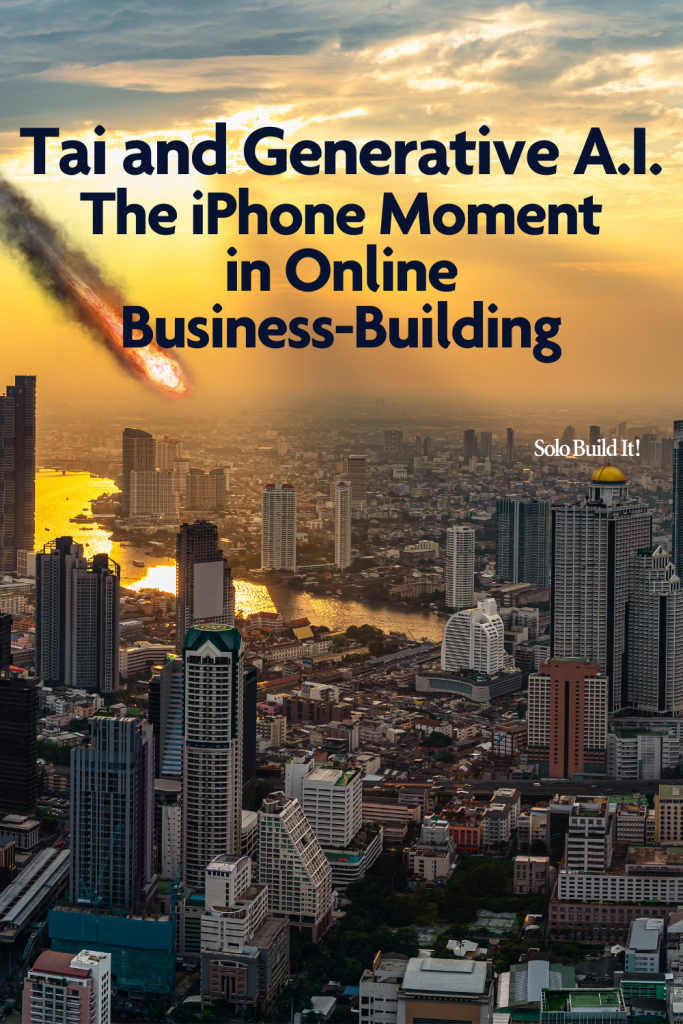 Gradually, and then all at once, we lived in a world where individual freedom and personal riches/fulfillment were no longer pipe dreams.
Gradually, and then all at once, we lived in a world where individual freedom and personal riches/fulfillment were no longer pipe dreams.
And today?
Historians will regard this period as the pinnacle of innovation. They’ll identify 2023 as the pivotal year, the inflection point that led us into an unimaginably brilliant future.
In Part 2, I discuss Generative Artificial Intelligence (GAI), how it infuses and magnifies those four new disruptive platforms and many major new technologies that will leave this planet almost unrecognizable…
… gradually, then all at once.
You’ll see how this is important at a global level and, at the nitty-gritty level, for growing your online business bigger and more profitable than ever.
See you in Part 2.
All six parts will be available here as they’re published.
By the way, if you have questions or comments, please leave them below, I read them all and will answer many.
Ditto for using A.I. to grow an online business: Is there a topic I haven’t covered? Let me know how you would like me to extend the series by replying to the above tweet. I’m all 👂s!
Until we meet again, be great.
Images by DALL-E and Midjourney.
I first wrote this series of blog posts to prepare SBI! members (“SBIers”) for our upcoming launch of Tai, every SBIer’s revolutionary personal assistant, which is much more than the integration of GPT-4 into SBI!’s content creation process….
- Prompt Build It! and the Community Prompt Library enable SBIers to build or find the perfect prompt that maximizes and optimizes the…
- high quality of the content generated by Tai using GPT-4 and the unique Boxchain process, while…
- StyleBuilder enables Tai to write in any style, including an enhanced version of the SBIer’s. And finally, to top it all off…
- The Tai Action Guide contains the step-by-step process, along with all the information that every SBIer needs to know. No need to worry about the vast amounts of information about A.I. being created every day — we do that for them.
The result, in true SBI! fashion, is the empowerment of SBIers by providing all they need under one roof, a combination of the right tools and step-by-step process supported by up-to-date information. This enables everyday people to get up and running right away, creating better and more effective content than ever, faster than ever.
This alone is enough to extend SBIers’ already large traffic-building advantage. But, as the saying goes…
You ain’t seen nuthin’ yet!
We’re super-excited about the quality and usefulness of this series of posts, as well as the world-changing impact of A.I. So, in the open source spirit of the A.I. community, we decided not to tuck this important information inside Solo Build It!, but to share it with you, too.
It’s vital that solopreneurs understand the context of this amazing time, and their place within it. Developing this understanding builds the perspective and conviction necessary to commit to the new ways of working that will generate better results than ever before seen.
We hope you find this series to be as useful as we believe it to be!
